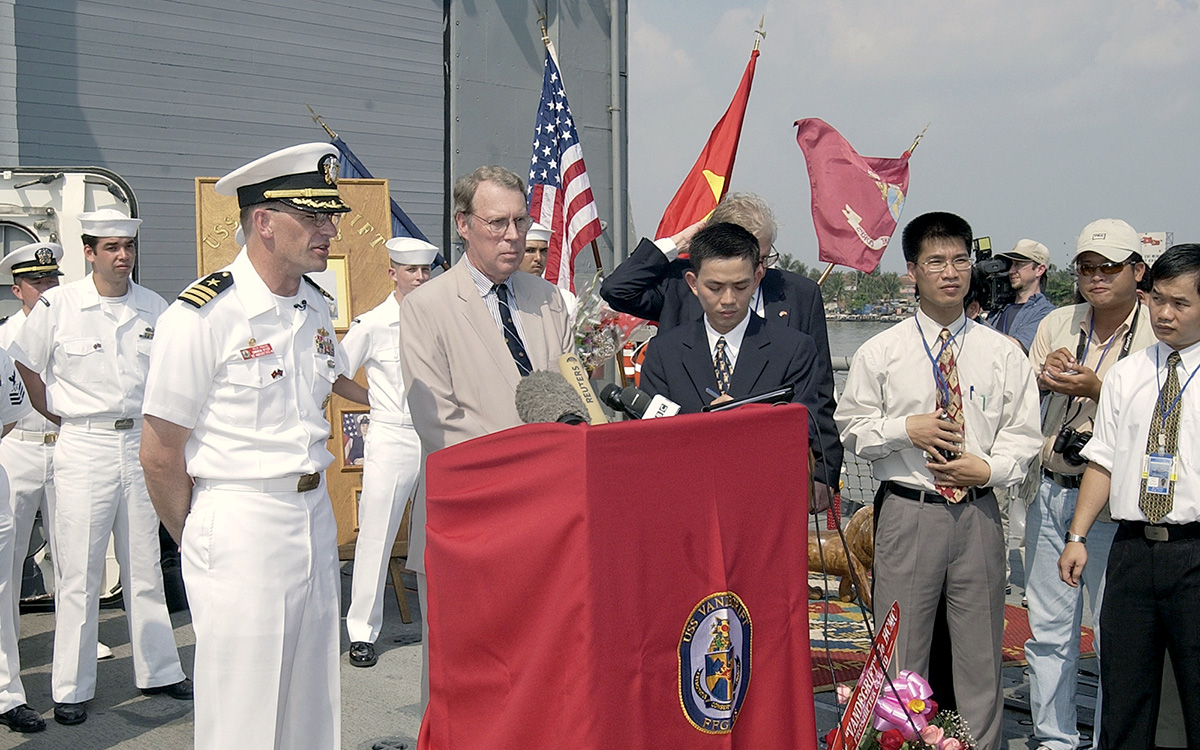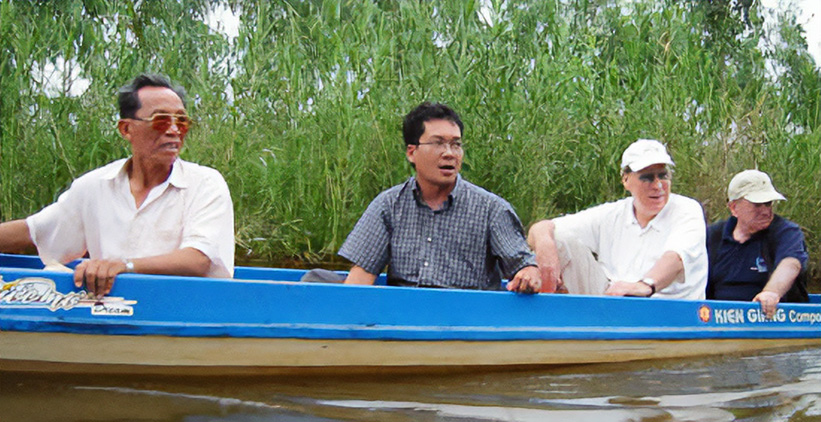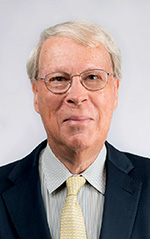The Last Steps of Normalization: Reflections of the U.S. Ambassador to Vietnam, 2001-2004
Completion of the normalization process got a boost when Vietnam’s leadership determined that “the triangle” (Vietnam, China, U.S.) was out of balance.
BY RAYMOND BURGHARDT

U.S. Ambassador to Vietnam Raymond Burghardt (center) joins the commanding officer of the USS Vandegrift, Cdr. Richard Rogers (to his right), for a press conference aboard the ship in Ho Chi Minh City on Nov. 19, 2003. This marked the first U.S. Navy ship visit to Vietnam in 30 years.
Gary Granger / U.S. Navy
George W. Bush nominated me to be the second U.S. ambassador to a unified Vietnam. I would return after 28 years to the country where I began my Foreign Service career during the war, first seconded to USAID and then as a political officer. I knew that the chief advocate for my nomination was Deputy Secretary of State Rich Armitage, whom I accompanied in March 1982, when he was a deputy assistant secretary of Defense, on one of the first missions to negotiate normalization of relations. The process would take 13 more years until ambassadors were exchanged.
For both me and my wife, Susan, who had been with me in Saigon from 1970 to 1973 as manager of the USO’s “Call Home Service” for the U.S. military, return to Vietnam prompted many emotional moments when we felt as if we were picking up the thread of the long story of U.S.‐Vietnam relations.
As I prepared for confirmation in fall 2001, the message I received from Senator John McCain and Senator John Kerry, the two senators who had been the strongest advocates for restoring U.S.‐Vietnam relations, was that Pete Peterson, the first postwar ambassador, had made a great start, and now my job was to complete the process of normalization.
A Step-by-Step Process
Our bilateral relationship had developed in identifiable stages, the work of which continued as new areas of cooperation were added. Three important areas weren’t there yet: military-to-military relations, law enforcement cooperation, and an intelligence liaison relationship. These would be tough, the most sensitive issues. They involved the people on both sides who would be most wary and, in many cases, most embittered about the war, particularly on the Vietnamese side. In my meetings with Secretary of State Colin Powell and Deputy Secretary Armitage, they stressed exactly the same goals.
From the early 1990s, even before normalization, cooperation began in dealing with the legacy issues remaining from the war: returning the remains of those missing in action (MIAs), reuniting refugees with family members remaining in Vietnam, and demining and removing unexploded ordnance. Then came economic engagement.
Our bilateral trade agreement was signed a few days before I arrived in Hanoi as ambassador on Dec. 15, 2001, and was quickly followed by agreements on textiles and civil aviation. The U.S. was soon Vietnam’s biggest trade partner. Intel’s decision to build a multibillion-dollar manufacturing and testing facility near Ho Chi Minh City was a critical step for Vietnam in moving from basic manufacturing to high tech.
Humanitarian and educational cooperation were also strong. We had one of the largest Fulbright programs in the world. And President George W. Bush designated Vietnam, which managed the SARS epidemic well, as the only Asian country to benefit from a special fund for HIV/AIDS, the President’s Emergency Plan for AIDS Relief (PEPFAR). This progress was encouraging, but I soon realized that I had come during a period of some tension in the relationship.
On Easter Day 2001, large and at times violent demonstrations had broken out in the Central Highlands. Ethnic minority people—often known as “Montagnards,” the name given to them by the French—protested harassment of their Christian house churches, which were not officially recognized by the state. A more fundamental cause of discontent was that ethnic Vietnamese had been occupying the indigenous peoples’ land to develop coffee plantations. The army suppressed the demonstrators, and many fled to Cambodia.
By December, when I arrived, the United Nations High Commission for Refugees (UNHCR) had repatriated some of these people back to Vietnam. UNHCR wanted to visit the Central Highland provinces to confirm that conditions permitted continued repatriation. Vietnam resisted the inspections. The Bush administration was giving a lot of attention to this issue, which soured the relationship somewhat. Progress slowed as important sectors in both countries remained wary about improving ties.
The Breakthrough

Traveling by punt boat in Vietnam’s Mekong Delta on July 16, 2002, Ambassador Raymond Burghardt (second from right) observed U.S.-funded disaster relief projects in the U Minh Thuong National Park. Also pictured: Bành Văn Đởm (far left), director of the U Minh Thuong National Park, and Nguyễn Hữu Thiện (second from left), field project manager for the U Minh Thuong Nature Reserve Conservation and Community Development Project, CARE International in Vietnam.
U.S. Consulate General Ho Chi Minh City
The breakthrough in U.S.-Vietnam relations came on July 12, 2003, at a regular plenary meeting of the Central Committee of the Vietnamese Communist Party. The meeting focused on Vietnam’s strategic position in the world. Immediately following the plenum, Deputy Foreign Minister Le Van Bang asked to meet. Bang, who had been Vietnam’s ambassador in Washington, was my key contact. We met regularly one-on-one to manage the relationship. He informed me that his country’s leadership had concluded that “the triangle is out of balance.” The triangle was Vietnam, China, and the United States.
Hanoi had improved relations with Beijing, overcoming serious differences. But they remained deeply concerned about a stronger China throwing its weight around, being more aggressive in the South China Sea where Hanoi has competing claims, and improving ties with Cambodia and Laos, which Vietnam considers in its sphere of influence. The geostrategic trend was going in the wrong direction. Hanoi wanted improved ties with Washington to create a better balance. Human rights issues had strained our ties; now we should focus on our strategic relationship.
Bang was very concrete about what should happen next. The U.S. had suggested that Vietnam’s defense minister visit Washington, D.C., in reciprocation for Secretary of Defense William Cohen’s visit to Hanoi a few years earlier, and that should now take place as soon as possible. The U.S. had also proposed that a U.S. Navy ship make a port visit in Vietnam; that should happen very soon after the defense minister’s trip. A day or two later, Bang added another item—a proposal that Deputy Prime Minister Vũ Khoan, number two in the government and secretary of the politburo, a key party position, visit the United States and meet everyone he could in Washington.
Defense Minister Phạm Văn Trà met Secretary of Defense Donald Rumsfeld at the Pentagon in early November 2003. Later that month the USS Vandegrift sailed up the Saigon River waving the Stars and Stripes next to the Vietnamese flag and docked at the Port of Saigon. Susan and I were on board, chatting with young sailors whose fathers had fought in the war. The ship visit was a profound signal of good relations—to Vietnam’s own people, to the U.S., and to Beijing. Vietnam had invited back an American warship, an iconic symbol of the military power of its former enemy.
In early December, Deputy Minister Bang and I accompanied Deputy PM Khoan on a trip to San Francisco, Houston, New York, and Washington, D.C. In Houston, former President George H.W. and Barbara Bush hosted the delegation for lunch at their home. This extraordinary gesture was correctly seen by the Vietnamese as a clever way to compensate for the fact that protocol considerations had ruled out a meeting with his host’s son in the White House.
New Progress
In Washington, Khoan met with Secretary of State Colin Powell, National Security Adviser Condoleezza Rice, and many members of Congress. Deputy Secretary of State Armitage commented to me on how remarkable he found Khoan’s openness to discuss Vietnam’s anxieties about Beijing: This was a sea change, Armitage said, probably the most important consequence of Khoan’s trip. Khoan talked about China’s aggressiveness, asked what the U.S. planned to do about China, and if the U.S. could help Vietnam’s military.
When we got back to Hanoi, I found another aspect of improved relations: Access to the top leadership opened up. I met for the first time the party’s general secretary, Nông Đức Mạnh. Equally important, the meeting was front-page news in Vietnam. The foreign ministry then arranged for me to meet, one by one, all the members of the politburo. Two of them became key contacts whom I met regularly.
Now that both sides had begun to see each other as useful in maintaining the regional balance of power, it became easier to develop those three missing aspects of the relationship—military, law enforcement, and intelligence cooperation. Military ties developed through continued port calls, visits from Honolulu by our Pacific commanders, and beginning the sale of some military equipment to Vietnam. Our Drug Enforcement Administration office in Hanoi led the way on improving law enforcement relations, including visits by FBI officers based in Bangkok. We sent lots of Vietnamese police to our training facility in Bangkok and signed a mutual legal assistance agreement.
Establishing an intelligence liaison relationship, with declared chiefs of station (COS), was the last piece to put in place. Our first declared COS visited the day before I departed post. I introduced him to Vietnam’s minister of public security, and he returned to begin his tour of duty during the time of my successor, Mike Marine.
In Conclusion, a Story
I could tell many stories about meeting Vietnamese I had known during the war or about events that evoked memories of the early 1970s. Here is one: In January 2002, on my first visit to Ho Chi Minh City as U.S. ambassador, I attended a concert sponsored by the U.S. government at the conservatory. During the intermission, a man walked up to me and said, “Good to see you again.” He looked vaguely familiar.
I asked if we had met when I was there in the 1970s. He asked if I remembered when Vice President Spiro Agnew met with President Nguyễn Văn Thiệu of the ill-fated southern government. I said I did: it was in late 1972. I had come as the notetaker with Agnew and Ambassador Ellsworth Bunker. My friend, now smirking broadly, said he was there as special assistant for public affairs to President Thiệu.
What did he do now? He was editor in chief of Thanh Niên, the main Communist Party newspaper in Ho Chi Minh City, he said. When I returned to Hanoi and asked my friend Deputy Foreign Minister Bang about this unusual guy, Bang collapsed in laughter. “Ray,” he said, “let’s put it this way. No one can ever be that rehabilitated.”
My new old friend had been on the other side all along, right in the inner circle of the presidential palace. No wonder the Saigon government lost.
When sharing or linking to FSJ articles online, which we welcome and encourage, please be sure to cite the magazine (The Foreign Service Journal) and the month and year of publication. Please check the permissions page for further details.
Read More...
- “Old Enemies Become Friends: U.S. and Vietnam” by Raymond Burghardt, The Brookings Institution, November 2006
- “Counterinsurgency in Vietnam: Lessons for Today” by Rufus Phillips, The Foreign Service Journal, April 2015
- “Lessons from Vietnam: Why the War Still Resonates Today,” GW Today, May 2023



